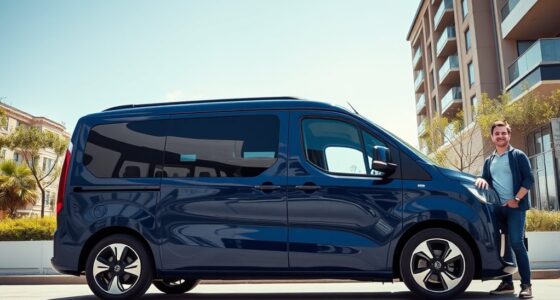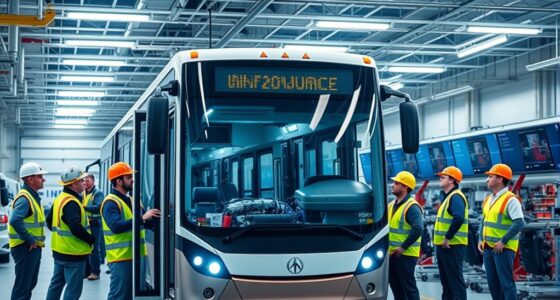Electric buses are designed with your safety and comfort in mind. They feature advanced fire prevention systems, quiet electric motors, and smooth rides that reduce noise and jerks. Inside, you’ll find ergonomic seating, climate control, and modern amenities that make your journey pleasant. Strict safety standards and thermal management keep fires rare and improve reliability. If you want to learn how these buses ensure your safety and enhance your travel experience, keep exploring the details below.
Key Takeaways
- Electric buses operate quietly, reducing noise pollution and enhancing passenger comfort during journeys.
- Advanced thermal management and safety systems prevent battery overheating, ensuring passenger safety.
- Regular safety inspections and fire suppression systems minimize fire risks and protect passengers.
- Modern electric buses feature ergonomic seating, climate control, and infotainment for a comfortable ride experience.
- Strict safety standards and monitoring boost passenger confidence in electric bus reliability and safety.

Electric buses are transforming public transportation by offering a safer and more comfortable experience for passengers. While all vehicles carry some risk, electric buses have relatively low fire incidents compared to traditional fuel-powered buses. The high-voltage lithium-ion batteries they use can, in rare cases, experience thermal runaway, which may lead to fires. Since 2010, at least 27 confirmed battery fires have been reported worldwide, but these are still infrequent. In fact, electric buses are less prone to fires than gasoline or diesel vehicles, and ongoing advances in depot and charging hub designs help reduce the risk further. Many electric buses come equipped with safety features like fire suppression systems, which quickly detect and respond to potential fires, helping minimize damage and protect passengers. Additionally, implementing comprehensive safety protocols and battery monitoring systems can further enhance onboard safety and early fire detection. Safety doesn’t stop at fire prevention. Regulatory bodies enforce strict standards to guarantee electric bus safety, including fire prevention measures, regular inspections, and safety testing. Research shows that incidents involving electric bus fires are rare, and injuries are even less common. These measures give passengers peace of mind, assuring them that safety is a top priority. Additionally, safety assessments employing models like the Extreme Learning Machine (ELM) and fuzzy C-mean clustering analyze safety data to categorize buses based on safety indicators such as speed, braking, and fire risk, enabling manufacturers and operators to identify safer models and improve overall safety features. Advances in battery technology continue to improve safety and reliability, reducing the likelihood of thermal runaway incidents. Furthermore, the development of thermal management systems helps maintain optimal battery temperatures, further decreasing fire risk and enhancing passenger confidence. These systems are crucial for preventing overheating and ensuring consistent performance. Beyond safety, electric buses considerably boost passenger comfort. They operate more quietly than traditional buses, reducing noise pollution and creating a more peaceful environment inside the vehicle. The smooth electric propulsion system means you won’t feel jerks or rough rides, making every journey more comfortable. The reduction of emissions from electric buses also improves air quality both outside and inside the bus, contributing to a healthier environment for passengers and those nearby. Modern electric buses often feature ergonomic seating, ample legroom, and climate control systems, ensuring you’re comfortable throughout your trip. Many are also equipped with advanced infotainment systems and convenient charging points, making your ride more enjoyable and practical.
Frequently Asked Questions
How Do Electric Buses Handle Extreme Weather Conditions?
You might wonder how electric buses perform in extreme weather. They adapt well through advanced thermal management systems that keep batteries at ideal temperatures, reducing energy loss.
In cold weather, spreading batteries evenly improves traction, while auxiliary heating options help maintain comfort.
During hot days, cooling systems protect batteries from degradation.
Drivers are trained to maximize routes and driving habits, ensuring safety and efficiency despite challenging conditions.
What Are the Noise Levels Inside Electric Buses During Operation?
You’ll notice that inside electric buses, noise levels are generally lower than in diesel buses, typically between 55-65 dB.
During operation, engine noise is minimal or absent, but you may still hear high-frequency sounds from power electronics, cooling systems, and wind noise.
These sounds can sometimes feel sharper or more noticeable, but overall, electric buses provide a quieter ride, enhancing comfort and communication for passengers.
How Is Passenger Safety Ensured During Battery Maintenance or Emergencies?
Imagine a fortress guarding its treasure—that’s how your safety is protected during battery maintenance or emergencies. You’re kept safe through rigorous training for drivers and first responders, automatic shutdowns, and advanced warning systems that act like vigilant sentinels.
Battery modules are encased and mechanically protected, ensuring no harm comes to passengers. These safety measures work together like an unbreakable shield, prioritizing your safety in every situation.
Are There Specific Safety Features Unique to Electric Bus Designs?
You’ll find electric buses equipped with unique safety features like automatic electrical disconnect systems that activate during crashes or shorts, isolating high-voltage parts.
Reinforced battery enclosures and high-voltage cable routing minimize impact risks.
Thermal management, including active cooling and thermal runaway prevention, keeps batteries safe.
Emergency protocols, such as high-voltage deactivation and fire-resistant compartments, guarantee quick response.
These innovations set electric buses apart in safety and resilience.
How Do Electric Buses Accommodate Passengers With Disabilities?
Imagine opening a door to a world where mobility barriers disappear. Electric buses embrace passengers with disabilities through low-floor designs that glide in seamlessly, onboard ramps that open new pathways, and wider doors for easy access.
Securement systems hold wheelchairs steady like anchors, while priority seating and grab bars offer safe havens. These thoughtful features transform rides into accessible journeys, empowering every passenger to travel with dignity and confidence.
Conclusion
You might think safety is just about avoiding accidents, but in electric buses, it also means ensuring comfort in silence and smooth rides. While cutting-edge technology reduces emissions, it must also prioritize passenger well-being. Balancing innovation with comfort creates a journey that’s both safer and more pleasant. Ultimately, the true measure of an electric bus isn’t just in its eco-friendliness, but in how comfortably and securely you feel as you travel.









